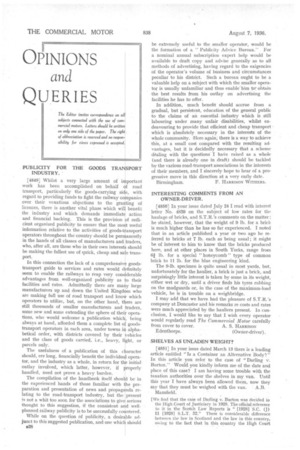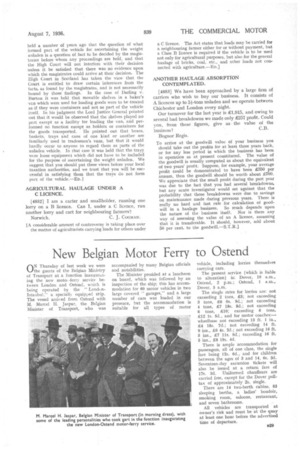01 1 11\ IONS
Page 38

Page 39

If you've noticed an error in this article please click here to report it so we can fix it.
and
QUERIES
PUBLICITY FOR THE GOODS TRANSPORT INDUSTRY. •
[4849] Whilst a very large amount of important work has been accomplished on behalf of road transport, particularly the goods-carrying side, with regard to providing funds to fight the railway companies over their vexatious objections to the granting of licences, there is another vital phase which will benefit the industry and which demands immediate action and financial backing. This is the provision a sufficient organized publicity to ensure that the mot useful information relative to the activities of goods-transport operators throughout the country should be perraanently in the hands of all classes of manufacturers and traders, who, after all, are those who in their own interests should be making the fullest use of quick, cheap and safe transport.
In this connection the lack of a comprehensive goodstransport guide to services and rates would definitely seem to enable the railways to reap very considerable advantages from well-organized publicity as to their facilities and rates. Admittedly there are many large manufacturers up and down the United Kingdom who are making full use of road transport and know which operators to utilize, but, on the other hand, there are still thousands of smaller manufacturers and traders, some new and some extending the sphere of their operations, who would welcome a publication which, being always at hand, afforded them a complete list of goodstransport operators in each area, under towns in alphabetical order, with districts covered by their vehicles and the class of goods carried, i.e.., heavy, light, or parcels only.
The usefulness of a publication of this citaracter should, ere long, financially benefit the individual operator, and the industry as a whole, in return for th.i. initial outlay involved, which latter, however, if properly handled, need not prove a heavy burden.
The compilation of the handbook itself should be in the experienced hands of those familiar with he preparation and presentation of news and propaganda relating to the road-transport industry, but the present is not a whit too soon for the associations to give serious thought to this suggestion, if the consistent and wellplanned railway publicity is to be successfully countered.
While on the question of publicity, a desirable adjunct to this suggested publication, and one which should s2S be extremely useful to the smaller operator, would be the formation of a " Publicity Advice Bureau." For a nominal annual subscription expert help would be available to draft copy and advise generally as to all methods of advertising, having regard to the exigencies of the operator's volume of business and circumstances peculiar to his district. Such a bureau ought to be a valuable help on a subject with which the smaller operator is usually unfamiliar and thus enable him to obtain the best results from his outlay on advertising the facilities he has to offer.
In addition, much benefit should accrue from a gradual, but persistent, education of the general public to the claims of art essential industry which is still labouring under many unfair disabilities, whilst endeavouring to provide that efficient and cheap transport which is absolutely necessary in the interests of the whole community. Here again, there is a way to achieve this, at a small cost compared with the resulting advantages, but it is decidedly necessary that a scheme dealing with the questions I have raised as a whole (and there is already one in draft) should be tackled by the various road-transport associations in the interests of their members, and I sincerely hope to hear of a progressive move in this direction at a very early date.
Birmingham. F. HARRISON WITHERS.
INTERESTING COMMENTS FROM AN OWNER-DRIVER.
[4850] In your issue dated July 24 I read with interest letter No. 4839 on the subject of low rates for the haulage of bricks, and S.T.R.'s comments on the matter ; he stated, however, that the weight of 9 lb. for a brick is much higher than he has so far experienced. I noted that in an article published a year or two ago he referred to bricks at 7 lb. each as being usual ; it might be of interest to him to know that the bricks produced here, and at other places in South Yorks, range from 61 lb. for a special " honeycomb " type of common brick to 11 lb. for the blue engineering kind.
The 9-1b. specimen is quite usual in most yards, but, unfortunately for the haulier, a brick is just a brick, and surprisingly little interest is taken by some in its weight, either wet or dry, until a driver finds his tyres rubbing on the mudguards or, in the case of the maximum-load vehicle, he is in trouble on a weighbridge.
I may add that we have had the pleasure of S,T.R.'s company at Doncaster and his remarks re costs and rates were much appreciated by the hauliers present. In conclusion, I would like to say that I wish every operator would regularly read The Commercial Motor carefully
from cover to cover. A. S. HARRISON Edenthorpe. (Owner-driver).
SHELVES AS UNLADEN WEIGHT?
[4851] In your issue dated March 13 there is a leading article entitled "Is a Container an Alternative Body?" In this article you refer to the case of "Darling v. Burton." Would you kindly inform me of the date and place of this case? I am having some trouble with the taxation authorities over the shelves in my van. Until this year I have always been allowed them, now they say that they must be weighed with the van. A.B. Mansfield.
[We find that the case of Darling v. Burton was decided in the High Court of Justiciary in 1928. The official reference to it in the Scotch Law Reports is " [1928] S.C. (J) 11 [19281 S.L.T. 32." There is considerable difference between the law in Scotland and the law in this country, owing to the fact that in this country the High Court
held a number of years ago that the question of what formed part of the vehicle for ascertaining the weight unladen is a questiou of fact to be decided by the magistrates before whom any proceedings are held, and that the High Court will not interfere with their decision unless it be satisfied that there was no evidence upon which the magistrates could arrive at their decision. The High Court in Scotland has taken the view that the Court is entitled to draw certain inferences from the facts, as found by the magistrates, and is not necessarily bound by those findings. In the case of Darling v. Burton it was held that movable shelves in a baker's van which were used for loading goods were to be treated as-if they were containers and not as part of the vehicle itself. In his judgment the Lord justice General pointed out that it would be observed that the shelves played no part except as a facility for loading the van, and performed no function except as holders or containers for the goods transported. He pointed out that boxes, baskets, trays and cans of one kind or another are familiarly used in tradesmen's vans, but that it would hardly occur to anyone to regard them as parts of the unladen vehicle. In that case it was held that the tray were loose equipment which did not have to be included for the purpose of ascertaining the weight unladen. We suggest that you should put these views before your local taxation authorities, and we trust that you will be successful in satisfying them that the trays do not form part of ihe vehicle.—Eral
AGRICULTURAL HAULAGE UNDER A C LICENCE.
[4852] I am a carter and smallholder, running one lorry on a B licence. Can I, under a C licence, run another lorry and cart for neighbouring farmers?
Norwich. C. J. COGMAN.
LA considerable amount of controversy is taking place over the matter of agriculturists carrying loads for others under a C licence. The Act states that loads may be carried for a neighbouring farmer either for or Without payment, but a Class B licence is required if the vehicle is to be used not only.for agricultural purposes, but also for the general haulage of bricks, coal, etc., and other loads not connected with agriculture.—En.]
ANOTHER HAULAGE ABSORPTION CONTEMPLATED.
[4853] We have been approached by a large firm of carriers who wish to buy our business. It consists of A licences up to 5i-tons unladen and we operate between Chichester and London every night.
Our turnover for the last year is 21,915, and owing to several bad breakdowns we made only £257 profit. Could you, from these figures, give us • the value of the business? • C.B.
Bognor Regis.
To arrive at the goodwill value of your business you should take out the profits for at least three years back, or for any less period in which the business has been in operation as at present constituted. The value of the goodwill is usually computed as about the equivalent of two years' profit. Suppose, for example, your average profit could be demonstrated to have been £350 per annum, then the goodwill should be worth about £700. We appreciate that the small profit during the past year was due to the fact that you had several breakdowns, but any acute investigator would set against that the probability that those breakdowns were due to savings on maintenance made during previous years. There is really no hard and fast rule for calculation of goodwill in a haulage business. So much depends upon the nature of the business itself. Nor is there any way of assessing the value of an A licence, assuming that it is transferable. It should, however, add about 50 per cent to the goodwill.—S.T.R.J




















































































